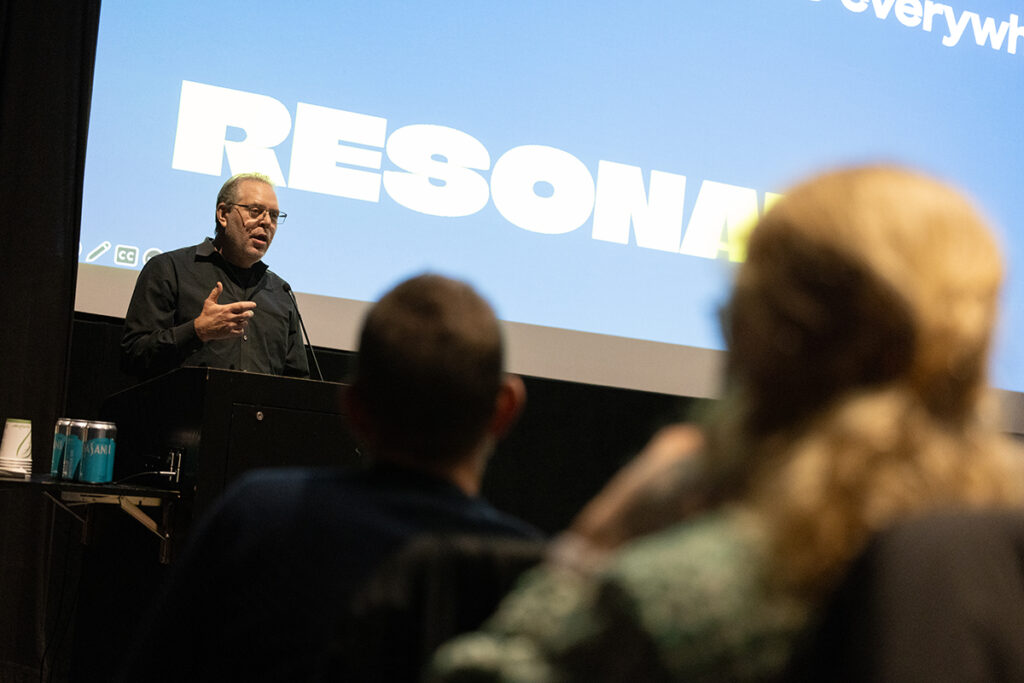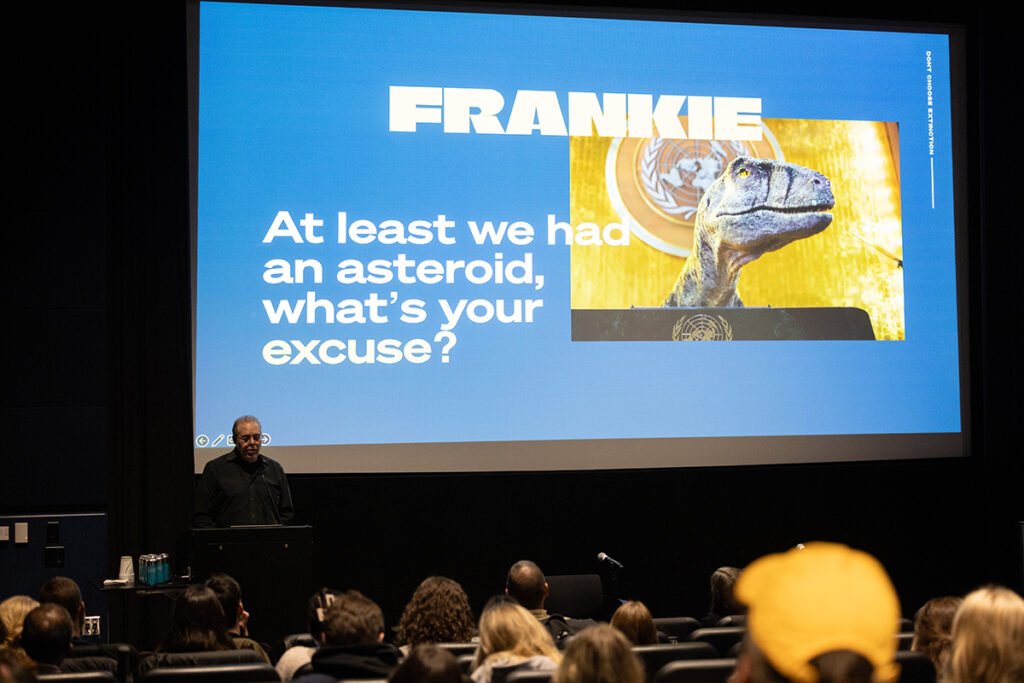UN Creative Director on Where Storytelling and Sustainability Meet

Emerson and its graduates have a big role to play in securing a sustainable future, because communicators, artists, and storytellers will be the ones who find a way to spread the word about what we need to do to achieve it.
That was the message Boaz Paldi, Chief Creative Officer for the United Nations Development Programme brought as the third-annual Teach-In on Sustainability keynote speaker on Thursday, November 21, in the Bright Family Screening Room.
The Teach-In, held November 20-22 across campus, showcased the ways faculty, staff, and students are exploring important questions about sustainability through presentations, panels, workshops, film, theatre, music, and more.
Read: Voice from Global South Discuss Sustainable Public Health Approaches
Watch: Compost Concert Unites Art & Sustainability
Emerson approaches sustainability not solely as a response to the climate crisis – though that is a critical part of the conversation – but through the lens of the UN’s 17 Sustainable Development Goals, which encompass environment, health, justice, food security, and much more.
“We approach a concept of sustainability that encompasses all aspects of individual and societal wellbeing, and we do that as only Emerson can,” Provost Alex Socarides said in introducing Paldi.
Here are some takeaways from Paldi’s keynote:
Find Your Audience, and a Way to Speak to Them
The United Nations has a lot of very good scientific information to share, including the Intergovernmental Panel on Climate Change (IPCC) report, which is a blueprint of what is happening to the planet thanks to greenhouse gas emissions, pollution of our waterways, etc.
“It explains to us very clearly where the science is, where we need to go, and what’s happening to our earth,” Paldi said, “except … it’s impossible to read. It’s extremely dense.”
The IPCC has an audience – climate scientists, policy makers, doom scrollers – but if the climate crisis requires that everyone take action, the audience needs to be a little broader than that.
“What we need to do is not only find the audience, we need to somehow make our messages resonate with them,” he said. “We can’t overload them with science, and certainly we can’t keep saying that we’re all going to die, that does nothing…It creates apathy rather than action. So there has to be another way.”
So, You Go Get a Dinosaur
A number of years ago, Paldi was tasked with creating a public awareness campaign around fossil fuel subsidies. Those are the $680 billion in tax dollars governments give to oil and gas companies — a price-stabilizing policy that originated with the 1970s energy crisis, but which now just disincentivizes transitions to clean energy.
What Paldi and his team came up with was Frankie, a CGI dinosaur (voiced by Jack Black) that, in a two-and-a-half-minute video, pleads with UN ambassadors to stop subsidizing fossil fuels because he knows a thing or two about extinction, and that would be like if dinosaurs subsidized meteors. The spot had the hashtag #DontChooseExtinction.
“We know that people love to watch dinosaur films… and so if the dinosaur is funny…this crazy message that we saw that was so complicated and so complex and almost no one knows about around the world, might have resonance with the public. We might be able to get people to not only take notice, but actually perhaps take action… perhaps hold their leaders accountable to these crazy subsidies that we still have.”
Don’t Be Afraid to Drag People’s Kids into It
When it came time to ask ordinary people to take action, Paldi went straight for the heart.
The creatives at UNDP noticed that talking about the weather used to be something you’d do when you didn’t have anything else to say. Now, it’s headline news, all over the world — category 5 hurricanes, torrential rain and flooding, massive wildfires.
“We noticed another thing. We saw lots and lots of studies coming in from around the world that if we were to ask people to take climate action, the best way that we can do it is to remind us of our children, the next generation, of children in our lives,” Paldi said.
The team created a series of “weather reports” read, deadpan, by children warning of catastrophe and annihilation, while cracking jokes about their little brothers. They were filmed in dozens of languages and played during actual newscasts on more than 300 networks.
“We find a way that would resonate with the audience. This is not a doom and gloom campaign, it’s a campaign of hope,” he said.
That 2021 spot has gotten at least 2.4 billion views (Paldi stopped counting), Frankie has gone on to be a spokesperson for the cause on social media and in live global engagements, and fossil fuel subsidy reform made it onto the agenda of the COP29 climate summit, Paldi said.

Sustainability Can Be Fun
It’s important to get across to people that while the planet is facing existential danger, and it will take everyone living on it to start moving it in a more sustainable direction, the news isn’t all bad, and it’s in no way boring, Paldi said.
“There are enormous amounts of green jobs. There are enormous amounts of different aspects of science and innovation that are available to humanity at this time, so I don’t want to emphasize the fact that it’s hard,” Paldi said. “Yes, it’s going to be hard. Yes, there might be some sacrifices that we need to make, but it’s also the fact that it’s going to be fun, and it’s going to be exciting.”
Categories